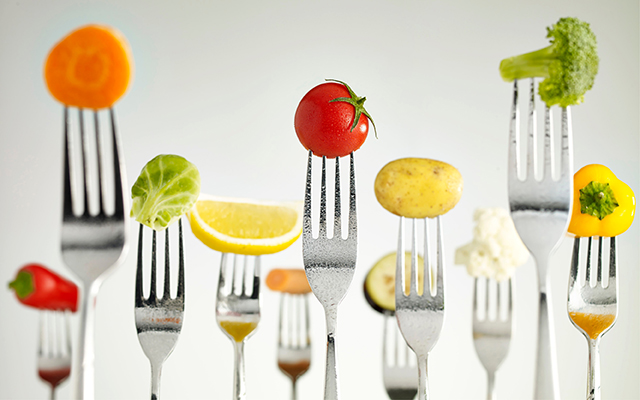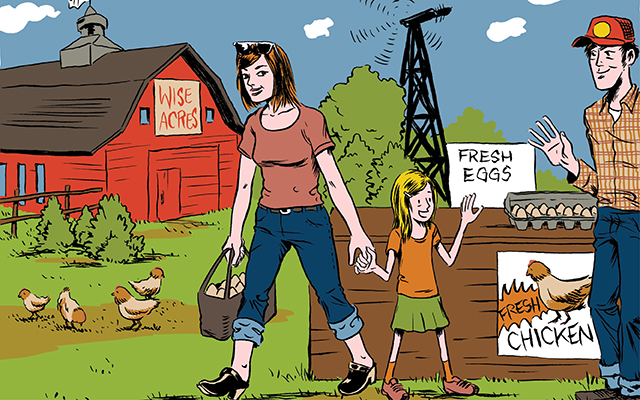The day I stumbled upon organic farming, I was not long out of college, new to the food-writing beat, and thinking ahead to hosting my first Thanksgiving — the Super Bowl and presidential election night of the food-writing calendar. It happened because I was simply curious whether or not it would make a difference if I chose to buy and prepare a heritage, organic Thanksgiving turkey, which at the time could be preordered from just a handful of farms.
When I started doing my research, I found that heritage birds were at least five times the price of regular grocery-store turkeys. Now, what I didn’t know at the time was that the buck-a-pound turkeys are loss leaders for grocery stores. That the goal is to get you in the door for the cheap turkey, which they lose money on, and make a hefty profit on all the soda, rice mixes and other prepackaged fillers people buy for the holidays. So, at first, all I could think was, why, oh why, would anyone pay that much for anything?
Ultimately, though, curiosity trumped frugality and, as summer turned to fall, I decided to order a bird. A dutiful reporter at heart, I made plans to visit the stubborn Iowa-based farmer who was raising it.
Late summer in northern Iowa is a sight to behold. As I navigated the country roads that led from the highway to the home of the heritage turkeys, I couldn’t help but goggle at the golden wonder. The land is toasty with corn, gilded with corn, sparkling with amber waves of corn.
Then I crested a hill and saw the farm I was looking for. I couldn’t miss it. That stubborn farmer — who had steadfastly refused to soak his land in chemicals, despite the fact that all his neighbors did so — told me I’d know his farm because he had hawks overhead. That didn’t quite prepare me for the Hitchcockian scene I came upon, however. In the sky over his neighbors’ land, in all four directions, there was hardly a bird in the sky. Above my heritage turkey’s home there were at least a hundred birds of prey spiraling overhead. The hawks that were wheeling over the organic land were so thick they looked almost fake, as if Mother Nature were using Photoshop.
When I finally met the farmer, he told me that when he was a boy, all the sky in the area was full of hawks. And it was at that moment that something in me was forever changed.
I was a New York City kid, a post-Watergate kid, and a post this-river-is-burning kid. I never knew the world when the skies were full of hawks. Yet, standing in that sea of corn, I felt as though I’d been gut-punched. I felt the staggering loss of all that was gone that I had never seen. And then the farmer informed me that a dead zone in the Gulf of Mexico, which has since grown to 7,000 square miles, was caused in part by runoff from farms like his neighbors’ and countless others like them, runoff that was full of poisonous pesticides designed to ensure high yields. The corn was being engineered to kill.
I drove back to the city, and more or less embarked on a career telling people to take better care of their bodies: to eat more vegetables grown without poisons; to support farmers who treat their land and animals with care; to shop at co-ops and farmers’ markets; and to embrace natural life, not an industrial death.
Some days, I wish I had something snazzier to say, some groundbreaking news that would change the conversation regarding healthy eating.
If only because it’s sometimes hard to find new ways to preach the same truth year after year: that we shouldn’t eat food poisoned by pesticides; that we shouldn’t flush those same pesticides into the ocean, where life begins. “For heaven’s sake,” I find myself saying again and again, “be thoughtful. Take care of your body and the land and the animals.
“Eat local, eat plants, and eat animals that roam free,” I say to my friends, in my food columns, on the radio and TV. And then I hit repeat.
That’s why I’m so grateful for Pandora’s Lunchbox: How Processed Food Took Over the American Meal, by Melanie Warner (Scribner, 2013). It’s a horror show, but it’s an essential piece of journalism that’s sure to reawaken conversations about clean, ethical eating.
I haven’t exactly ignored the particular dangers of the processed food that Warner writes about, but I’ll admit I’d become a little complacent on the subject. To be honest, this is in part because I kind of forget it’s out there sometimes.
I gave up fast food years ago, partly because I lost my taste for it: After not eating McDonald’s for five years, I tried a Big Mac on a road trip and couldn’t get over how sugary it tasted. Sweet meat. Sweet sauce. Sweet bun. Who wants a burger to taste like a cupcake?
And I don’t know how it would happen that I’d ever order a Subway Sweet Onion Chicken Teriyaki sandwich — or think to break down its ingredients. But that’s exactly the sort of thing Warner did while working on her new book. Marketed as significantly healthier than a fast-food gut bomb, the Subway sandwich contains 105 ingredients, of which, Warner writes, “55 are dry, dusty substances,” such as azodicarbonamide.
What is azodicarbonamide? Well, it’s a known carcinogen used primarily to make foamy plastics, like yoga mats. In 2001, in fact, a semi-trailer full of the chemical overturned on the Dan Ryan Expressway in Chicago, and authorities deemed it so dangerous that motorists and residents near the accident were ordered to abandon their cars and evacuate their homes. Azodicarbonamide also happens to help make bread seem fluffy, which is why it’s used in almost every fast-food bread and bun, as well as in some Dunkin’ Donuts. And azodicarbonamide is just one of the more than 5,000 nonfood substances that are routinely added to processed food, Warner explains.
(Azodicarbonamide, by the way, is banned in Europe; it breaks down into a known carcinogen by the name of semicarbazide when heated. Needless to say, both bread and doughnuts require heat to assume their forms.)
BHA, butylated hydroxyanisole, is another additive featured in Pandora’s Lunchbox. Warner writes that it is “on California’s Proposition 65 list of cancer- or birth-defect-causing chemicals. The Department of Health and Human Services, of which the FDA is a part, has placed it on its list — a relatively short one — of substances ‘reasonably anticipated to be human carcinogens.’” Yet, the Food and Drug Administration allows BHA in some Kool-Aid, DiGiorno pepperoni pizza and McDonald’s sausages. Why? There’s no clear, convincing answer, except the most unsatisfying: that chemicals like these are used in such small amounts that they’re probably not harmful.
Even if this shallow analysis covered the thousands of suspect, nonfood substances we are routinely offered in processed food, there’s no accounting for what happens when these chemicals are combined. When sodium benzoate or potassium benzoate is mixed together with ascorbic acid (vitamin C), for instance, it forms benzene, a substance proven to cause leukemia. Nonetheless, Warner reports, “this [combination] occurs in products like Sunkist grape and orange sodas, Kool-Aid Jammers orange drink, Crystal Light Sunrise Classic Orange drink, and Giant Light Cranberry Juice Cocktail.”
According to Warner, if you eat “a Nutri-Grain bar in the morning, a Subway Chipotle Chicken and Cheese sandwich for lunch, and a DiGiorno pepperoni pizza for dinner, for instance, [you] will have ingested a total of 68 different nonfood additives” that haven’t been tested together.
How should we react to this lack of data and scientific rigor as we consider what to put into our tummies? Perhaps one could look to the Gulf of Mexico for ideas.
Pandora’s Lunchbox is the sort of electrifying journalism that comes around only once in a while. Read it. Especially if you’re experiencing fighting-the-good-fight fatigue, and starting to doubt that buying a head of lettuce at the farmers’ market is in fact a radical act — a health-giving, world-fixing, dead-zone-opposing radical act in a world where our daily “bread” can involve the manufacture of foamy plastics.




This Post Has 0 Comments